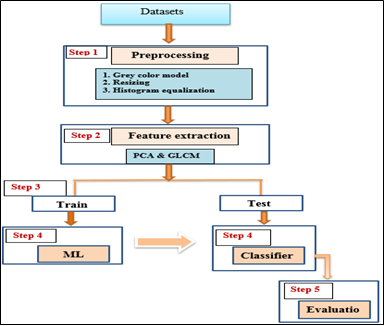Facial Expression Recognition: Machine Learning Algorithms and Feature Extraction Techniques
DOI:
https://doi.org/10.58564/IJSER.2.2.2023.67Keywords:
Face expression; Machine learning, Feature extraction, Random Fore, logistic regression. PCA, GLCMAbstract
Facial expression recognition (FER) systems accurately identify facial expressions by extracting facial features. The extraction of robust facial features comes after automatic face detection in this procedure. On the FAR2013 dataset, a five-step system developed to assess the performance of machine learning algorithms. Components of the system include preprocessing, feature extraction, model training and testing, classification, and evaluation. Three machine-learning algorithms utilized in this study: logistic regression (LR), random forest (RF), and AdaBoost (ADA). The RF algorithm achieved the highest degree of precision with a 61% success rate. The purpose of the study was to evaluate the performance of machine learning algorithms on the FAR2013 dataset. The study highlights the importance of facial feature extraction in FER systems and the precision of machine learning algorithms in facial expression recognition.
References
R. Khoeun, P. Chophuk, and K. Chinnasarn, “Emotion Recognition for Partial Faces Using a Feature Vector Technique,” Sensors, vol. 22, no. 12, 2022, doi: 10.3390/s22124633. DOI: https://doi.org/10.3390/s22124633
A. Majumder, L. Behera, and V. K. Subramanian, “Emotion recognition from geometric facial features using self-organizing map,” Pattern Recognit., vol. 47, no. 3, pp. 1282–1293, 2014, doi: 10.1016/j.patcog.2013.10.010. DOI: https://doi.org/10.1016/j.patcog.2013.10.010
Y. Cui, S. Wang, and R. Zhao, “Machine Learning-Based Student Emotion Recognition for Business English Class,” Int. J. Emerg. Technol. Learn., vol. 16, no. 12, pp. 94–107, 2021, doi: 10.3991/ijet.v16i12.23313. DOI: https://doi.org/10.3991/ijet.v16i12.23313
S. K. P.S and D. V.S, “Extraction of Texture Features using GLCM and Shape Features using Connected Regions,” Int. J. Eng. Technol., vol. 8, no. 6, pp. 2926–2930, 2016, doi: 10.21817/ijet/2016/v8i6/160806254. DOI: https://doi.org/10.21817/ijet/2016/v8i6/160806254
A. Jaiswal, A. Krishnama Raju, and S. Deb, “Facial emotion detection using deep learning,” 2020 Int. Conf. Emerg. Technol. INCET 2020, 2020, doi: 10.1109/INCET49848.2020.9154121. DOI: https://doi.org/10.1109/INCET49848.2020.9154121
J. Jia, Y. Xu, S. Zhang, and X. Xue, “The facial expression recognition method of random forest based on improved PCA extracting feature,” no. 1, pp. 0–4, 2016. DOI: https://doi.org/10.1109/ICSPCC.2016.7753643
K. Fawagreh, M. M. Gaber, and E. Elyan, “Random forests: From early developments to recent advancements,” Syst. Sci. Control Eng., vol. 2, no. 1, pp. 602–609, 2014, doi: 10.1080/21642583.2014.956265. DOI: https://doi.org/10.1080/21642583.2014.956265
R. Wang, “AdaBoost for Feature Selection , Classification and Its Relation with SVM * , A Review,” Phys. Procedia, vol. 25, pp. 800–807, 2012, doi: 10.1016/j.phpro.2012.03.160. DOI: https://doi.org/10.1016/j.phpro.2012.03.160
W. Gu, C. X. Ã, Y. V Venkatesh, D. Huang, and H. Lin, “Facial expression recognition using radial encoding of local Gabor features and classifier synthesis,” Pattern Recognit., vol. 45, no. 1, pp. 80–91, 2012, doi: 10.1016/j.patcog.2011.05.006. DOI: https://doi.org/10.1016/j.patcog.2011.05.006
Y. Wang, H. Ai, B. Wu, and C. Huang, “Real Time Facial Expression Recognition with Adaboost”.
S. Vijayarani and S. Priyatharsini, “Facial Feature Extraction Based On FPD and GLCM Algorithms,” pp. 1514–1521, 2015. DOI: https://doi.org/10.15680/ijircce.2015.0303016
C. X. Ã, “EMOTION DETECTION FROM FACE USING,” vol. 6, no. 6, 2019.
J. Kaur, “Facial Expression Recognition with PCA And LDA,” vol. 5, no. 6, pp. 6996–6998, 2014.
R. Bala and K. M. Braun, “Color-to-grayscale conversion to maintain discriminability,” Color Imaging IX Process. Hardcopy, Appl., vol. 5293, no. December 2003, p. 196, 2003, doi: 10.1117/12.532192. DOI: https://doi.org/10.1117/12.532192
V. P. Vishwakarma, S. Pandey, and M. N. Gupta, “Adaptive histogram equalization and logarithm transform with rescaled low frequency DCT coefficients for illumination normalization,” Int. J. Recent Trends Eng. Technol., vol. 1, no. 1, pp. 318–322, 2009.
A. Prajapati, S. Naik, and S. Mehta, “Evaluation of Different Image Interpolation Algorithms,” Int. J. Comput. Appl., vol. 58, no. 12, pp. 6–12, 2012, doi: 10.5120/9332-3638. DOI: https://doi.org/10.5120/9332-3638
S. Seeger and X. Laboureux, “Feature Extraction and Registration – An Overview,” no. August, 2015.
H. M. Ebied, “Feature extraction using PCA and Kernel-PCA for face recognition,” 2012 8th Int. Conf. Informatics Syst. INFOS 2012, no. January 2012, 2012.
S. Karamizadeh, S. M. Abdullah, A. A. Manaf, M. Zamani, and A. Hooman, “An Overview of Principal Component Analysis,” J. Signal Inf. Process., vol. 04, no. 03, pp. 173–175, 2013, doi: 10.4236/jsip.2013.43b031. DOI: https://doi.org/10.4236/jsip.2013.43B031
J. Kommineni, S. Mandala, M. S. Sunar, and P. M. Chakravarthy, “Accurate computing of facial expression recognition using a hybrid feature extraction technique,” J. Supercomput., vol. 77, no. 5, pp. 5019–5044, 2021, doi: 10.1007/s11227-020-03468-8. DOI: https://doi.org/10.1007/s11227-020-03468-8
A. R. Khan, “Facial Emotion Recognition Using Conventional Machine Learning and Deep Learning Methods: Current Achievements, Analysis and Remaining Challenges,” Inf., vol. 13, no. 6, 2022, doi: 10.3390/info13060268. DOI: https://doi.org/10.3390/info13060268
M. Sokolova and G. Lapalme, “A systematic analysis of performance measures for classification tasks,” Inf. Process. Manag., vol. 45, no. 4, pp. 427–437, 2009, doi: 10.1016/j.ipm.2009.03.002. DOI: https://doi.org/10.1016/j.ipm.2009.03.002
Y. Wang, Y. Li, Y. Song, and X. Rong, “Facial expression recognition based on auxiliary models,” Algorithms, vol. 12, no. 11, Nov. 2019, doi: 10.3390/a12110227. DOI: https://doi.org/10.3390/a12110227
Mohmmed, I. J., AL-Nuaimi, B. T., & Bakr, D. I. S. (2023). Machine Learning Prediction Models applied to Weather Forecasting: A survey. Al-Iraqia Journal for Scientific Engineering Research, 1(2), 80-85. DOI: https://doi.org/10.58564/IJSER.1.2.2023.74
Hummady, G. K., & Ahmad, M. L. (2022). A Review: Face Recognition Techniques using Deep Learning. Al-Iraqia Journal for Scientific Engineering Research, 1(1), 1–9. https://doi.org/10.33193/IJSER.1.1.2022.33 DOI: https://doi.org/10.33193/IJSER.1.1.2022.33

Downloads
Published
How to Cite
Issue
Section
License
Copyright (c) 2023 Hadeel Mohammed, Mohammed Nasser Hussain, Faiz Al Alawy

This work is licensed under a Creative Commons Attribution-NonCommercial-NoDerivatives 4.0 International License.
Deprecated: json_decode(): Passing null to parameter #1 ($json) of type string is deprecated in /var/www/vhosts/ijser.aliraqia.edu.iq/httpdocs/plugins/generic/citations/CitationsPlugin.inc.php on line 49









